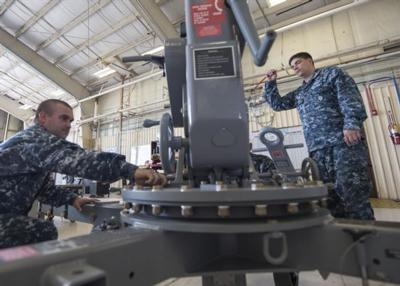Sailors Train At Eglin AFB With USAF 33rd Maintenance Squadron
Two Petty Officers 1st Class from the USS Abraham Lincoln received initial training from the Air Force’s 33rd Maintenance Squadron’s Aerospace Ground Equipment, or AGE, flight at Eglin Air Force Base, Aug. 7-11, 2017.

The Sailors, Petty Officers 1st Class Jeremiah Appel and Kunthea Sam, received the training in preparation for F-35C operations onboard their ship. In the future, when the F-35C is training aboard the Nimitz-class aircraft carrier, these technicians will be able to operate and maintain the aircraft.
“We are here to familiarize ourselves with what we can expect on the ship when F-35s are on board, allowing us to be fully functional,” said Appel, a CVN-72, trainee. “When we do return to our command we will be capable enough to handle any situations that come up.”
The 33rd MXS’s joint environment and extensive experience with both aircraft variants’ support equipment makes the maintainers here most qualified to train and develop the Sailor’s skills.
The AGE flight here has a unique mission supporting both the Air Force 58th Fighter Squadron’s F-35As and the Navy VFA-101’s F-35Cs. The Airmen and Sailors assigned to the unit work hand-in-hand with both aircraft. “(These Sailors) are here because we are the people who are the most capable of providing them with this training,” said 2nd Class Eric Stark a Navy Aviation Support Equipment Technician and a 33rd MXS Aerospace Ground Equipment trainer. “We’ve worked with this equipment the longest, making us the most experienced.”
The AGE flight operates and maintains the machines that supply electricity, air pressure and hydraulic pressure to the aircraft when the engine is not running. “An aircraft in the air is totally self-sufficient, meaning it maintains its own systems,” said Master Sgt. Jesse Cotter, the AGE flight chief. “When it’s on the ground it has none of that, so that’s where we come into play. Our support equipment does the same things the aircraft systems do, but while it’s on the ground.”
In the past, AGE technicians in the Air Force and Navy have worked with equipment that can be used across multiple legacy platforms. The majority of machinery that supports the Lightning II is particular to the aircraft, requiring specialized training. Additionally, the Navy’s fixtures will be different from the Air Forces when operating on an aircraft carrier. “Our equipment serves the same functions as theirs does, but some of their systems are a little bit smaller because of space constraints,” said Cotter.
When VFA-101 conducts their next set of training sorties on board the aircraft carrier, Stark and an Air Force member from the 33rd MXS will be onboard to provide “Phase 2” on-the-job training to the Sailors. “We are going out to the USS Abraham Lincoln so we can help them while (they are) out at sea and preparing them as they will eventually receive their own equipment for the F-35,” said Stark. “These are competent technicians. They will take what they learn here and use it to train other sailors in the future.”
According to Cotter, this cross branch training is another example of how the F-35’s joint warfighter capabilities have been successful. Mechanics who maintain the aircraft are able to easily learn from and support one another, helping to ensure mission success across the enterprise. “There may be subtle differences between how the Navy and Air Force do things, but we can always keep learning from one another because we are a part of the same mission,” said Stark. “We will always help each other where we can, regardless of our differences.”
(Image provided with USAF news release. Second Class Eric Stark, right, a Navy Aviation Support Equipment Technician and a 33rd Maintenance Squadron Aerospace Ground Equipment trainer, demonstrates how to operate a portable floor crane for 1st Class Jerimiah Appel, a Navy Aviation Support Equipment Technician on the USS Abraham Lincoln (CVN-72), Aug. 9, 2017, at Eglin Air Force Base, FL)
 Aero-News: Quote of the Day (12.18.25)
Aero-News: Quote of the Day (12.18.25) Classic Aero-TV: Viking Twin Otter 400--Bringing the DHC-6 Back Into Production
Classic Aero-TV: Viking Twin Otter 400--Bringing the DHC-6 Back Into Production NTSB Final Report: Rans Employee Flying Club Rans S-6ES Coyote II
NTSB Final Report: Rans Employee Flying Club Rans S-6ES Coyote II ANN FAQ: Submit a News Story!
ANN FAQ: Submit a News Story! ANN's Daily Aero-Term (12.18.25): Braking Action Advisories
ANN's Daily Aero-Term (12.18.25): Braking Action Advisories



